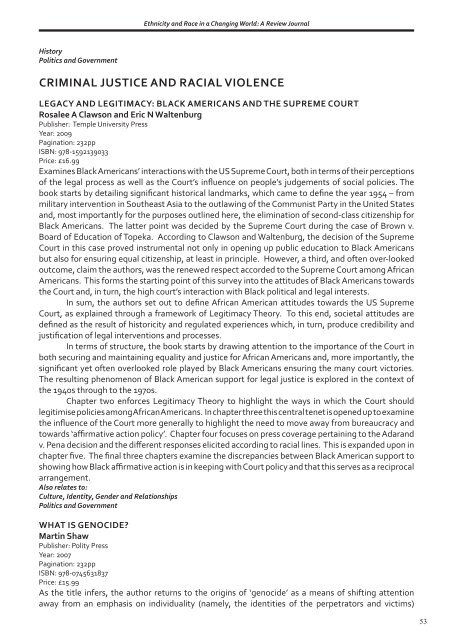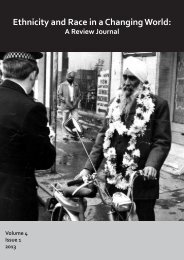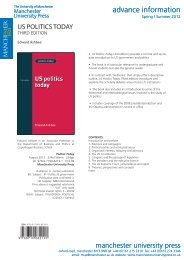Ethnicity and Race in a Changing World
Volume 2, Issue 1, 2010 - Manchester University Press
Volume 2, Issue 1, 2010 - Manchester University Press
- No tags were found...
You also want an ePaper? Increase the reach of your titles
YUMPU automatically turns print PDFs into web optimized ePapers that Google loves.
<strong>Ethnicity</strong> <strong>and</strong> <strong>Race</strong> <strong>in</strong> a Chang<strong>in</strong>g <strong>World</strong>: A Review JournalHistoryPolitics <strong>and</strong> GovernmentCRIMINAL JUSTICE AND RACIAL VIOLENCELEGACY AND LEGITIMACY: BLACK AMERICANS AND THE SUPREME COURTRosalee A Clawson <strong>and</strong> Eric N WaltenburgPublisher: Temple University PressYear: 2009Pag<strong>in</strong>ation: 232ppISBN: 978-1592139033Price: £16.99Exam<strong>in</strong>es Black Americans’ <strong>in</strong>teractions with the US Supreme Court, both <strong>in</strong> terms of their perceptionsof the legal process as well as the Court’s <strong>in</strong>fluence on people’s judgements of social policies. Thebook starts by detail<strong>in</strong>g significant historical l<strong>and</strong>marks, which came to def<strong>in</strong>e the year 1954 – frommilitary <strong>in</strong>tervention <strong>in</strong> Southeast Asia to the outlaw<strong>in</strong>g of the Communist Party <strong>in</strong> the United States<strong>and</strong>, most importantly for the purposes outl<strong>in</strong>ed here, the elim<strong>in</strong>ation of second-class citizenship forBlack Americans. The latter po<strong>in</strong>t was decided by the Supreme Court dur<strong>in</strong>g the case of Brown v.Board of Education of Topeka. Accord<strong>in</strong>g to Clawson <strong>and</strong> Waltenburg, the decision of the SupremeCourt <strong>in</strong> this case proved <strong>in</strong>strumental not only <strong>in</strong> open<strong>in</strong>g up public education to Black Americansbut also for ensur<strong>in</strong>g equal citizenship, at least <strong>in</strong> pr<strong>in</strong>ciple. However, a third, <strong>and</strong> often over-lookedoutcome, claim the authors, was the renewed respect accorded to the Supreme Court among AfricanAmericans. This forms the start<strong>in</strong>g po<strong>in</strong>t of this survey <strong>in</strong>to the attitudes of Black Americans towardsthe Court <strong>and</strong>, <strong>in</strong> turn, the high court’s <strong>in</strong>teraction with Black political <strong>and</strong> legal <strong>in</strong>terests.In sum, the authors set out to def<strong>in</strong>e African American attitudes towards the US SupremeCourt, as expla<strong>in</strong>ed through a framework of Legitimacy Theory. To this end, societal attitudes aredef<strong>in</strong>ed as the result of historicity <strong>and</strong> regulated experiences which, <strong>in</strong> turn, produce credibility <strong>and</strong>justification of legal <strong>in</strong>terventions <strong>and</strong> processes.In terms of structure, the book starts by draw<strong>in</strong>g attention to the importance of the Court <strong>in</strong>both secur<strong>in</strong>g <strong>and</strong> ma<strong>in</strong>ta<strong>in</strong><strong>in</strong>g equality <strong>and</strong> justice for African Americans <strong>and</strong>, more importantly, thesignificant yet often overlooked role played by Black Americans ensur<strong>in</strong>g the many court victories.The result<strong>in</strong>g phenomenon of Black American support for legal justice is explored <strong>in</strong> the context ofthe 1940s through to the 1970s.Chapter two enforces Legitimacy Theory to highlight the ways <strong>in</strong> which the Court shouldlegitimise policies among African Americans. In chapter three this central tenet is opened up to exam<strong>in</strong>ethe <strong>in</strong>fluence of the Court more generally to highlight the need to move away from bureaucracy <strong>and</strong>towards ‘affirmative action policy’. Chapter four focuses on press coverage perta<strong>in</strong><strong>in</strong>g to the Adar<strong>and</strong>v. Pena decision <strong>and</strong> the different responses elicited accord<strong>in</strong>g to racial l<strong>in</strong>es. This is exp<strong>and</strong>ed upon <strong>in</strong>chapter five. The f<strong>in</strong>al three chapters exam<strong>in</strong>e the discrepancies between Black American support toshow<strong>in</strong>g how Black affirmative action is <strong>in</strong> keep<strong>in</strong>g with Court policy <strong>and</strong> that this serves as a reciprocalarrangement.Also relates to:Culture, Identity, Gender <strong>and</strong> RelationshipsPolitics <strong>and</strong> GovernmentWHAT IS GENOCIDE?Mart<strong>in</strong> ShawPublisher: Polity PressYear: 2007Pag<strong>in</strong>ation: 232ppISBN: 978-0745631837Price: £15.99As the title <strong>in</strong>fers, the author returns to the orig<strong>in</strong>s of ‘genocide’ as a means of shift<strong>in</strong>g attentionaway from an emphasis on <strong>in</strong>dividuality (namely, the identities of the perpetrators <strong>and</strong> victims)53






